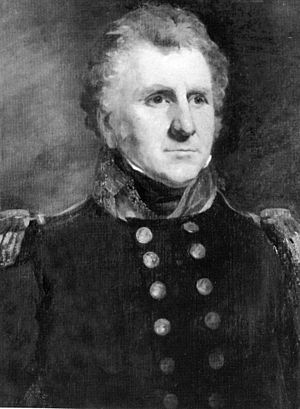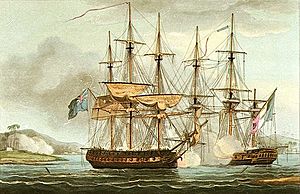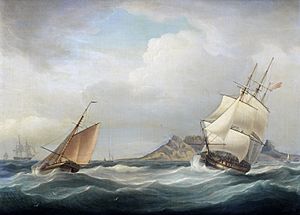Charles Adam facts for kids
Quick facts for kids
Sir Charles Adam
|
|
|---|---|

Admiral Sir Charles Adam
|
|
| Born | 6 October 1780 |
| Died | 19 September 1853 (aged 72) Greenwich, London |
| Allegiance | |
| Service/ |
|
| Years of service | 1790–1847 |
| Rank | Admiral of the Blue |
| Commands held | Sybille Chiffonne Resistance Invincible Impregnable Royal Sovereign North America and West Indies Station Greenwich Hospital |
| Battles/wars | Napoleonic Wars |
| Awards | Knight Commander of the Order of the Bath |
Admiral Sir Charles Adam (born October 6, 1780 – died September 19, 1853) was an important British naval officer. He served during the Napoleonic Wars, a series of major conflicts in Europe. He later became a Lord of the Admiralty, which meant he helped manage the Royal Navy.
Sir Charles Adam also commanded the royal yacht, a special ship for the King or Queen. He was even a Member of Parliament, helping to make laws for the country. He held the top naval job, First Naval Lord, three times. In this role, he managed the navy's money during peacetime. He also made sure the navy supported important missions, like removing forces from Syria in 1840. He also helped the navy keep up with new technology.
Contents
A Young Sailor's Start

Charles Adam was born in Scotland in 1780. He joined the Royal Navy when he was just 10 years old in 1790. This was a common age for boys to start their naval careers back then.
He served under his uncle, Admiral Lord Keith. He sailed in the Mediterranean Sea and helped capture the Cape of Good Hope (in modern-day South Africa) from the Dutch.
By 1795, he was made an acting lieutenant, a junior officer rank. He officially became a lieutenant in 1798. He quickly moved up the ranks, becoming a commander in 1798 and a captain in 1799.
Commanding Warships
As a captain, Adam took command of a frigate called Sybille. Frigates were fast, medium-sized warships. While commanding Sybille, he famously captured a French ship called Chiffonne near the Seychelles islands. This was a difficult but successful mission.
After returning from the East Indies in 1802, Adam commanded the captured Chiffonne in the North Sea until 1805. He then commanded other warships, including Resistance and Invincible. From 1811 to 1813, he operated off the coast of Spain. His active service ended in 1814.

After the wars, Charles Adam twice commanded the royal yacht, Royal Sovereign. This was a special honor, partly because of his father's political connections. In 1822, he married Elizabeth Brydone and they had several children.
In 1825, he was promoted to rear admiral, a higher naval rank. In 1831, he was elected as a Member of Parliament (MP) for Kinross-shire in Scotland. He continued to serve as an MP until 1841.
Sir Charles Adam held the important position of First Naval Lord three times. This role meant he was one of the most senior officers in charge of the Royal Navy.
During his time as First Naval Lord, he had to manage the navy's budget carefully, especially during peacetime when less money was available. He was known for handling these financial challenges well.
One major event during his time was the naval support for removing Muhammad Ali's forces from Syria in 1840. This showed the continued strength of the Royal Navy. He also made sure the navy kept up with new technology, like the development of the screw propeller for ships. He was promoted to vice admiral in 1837.
After leaving the Admiralty Board, Adam returned to sea command. From 1841 to 1844, he was the commander-in-chief of the North America and West Indies Station. He retired from active service in 1847 and became the Governor of Greenwich Hospital, a home for retired sailors. He was promoted to admiral in 1848.
Later Life and Legacy
Sir Charles Adam passed away in Greenwich on September 16, 1853. He was buried in Greenwich Hospital Cemetery. His name is listed on the Officers Monument there.
A place called Adam Bay, Northern Territory in Australia, located at the mouth of the Adelaide River, was named after him.


